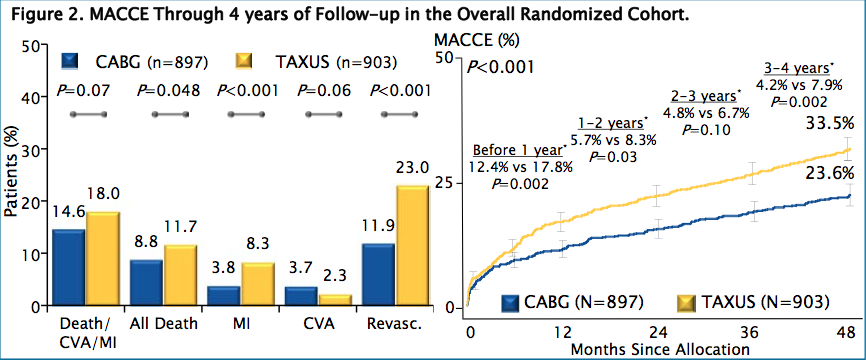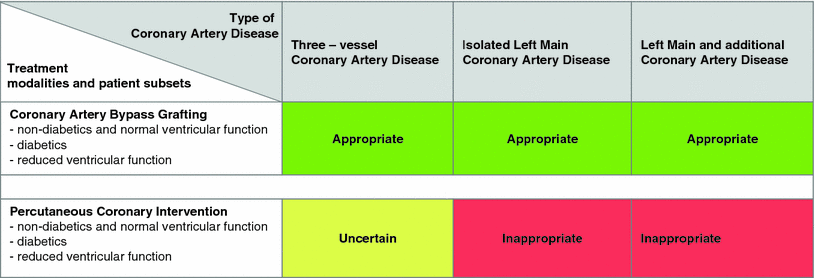Although 40-65% of patients admitted for treatment of an acute heart attack with percutaneous coronary intervention (PCI) have multiple blockages, current guidelines strongly suggest to limit the procedure to the blocked artery (the culprit vessel). PCI in “Non-culprit coronary arteries” is associated with a significantly increased risk of dying, as Armstrong and colleagues of the APEX-AMI trial recently published in …
More about Coronary Artery Bypass Grafting
While the buzz in treatment for Coronary Artery Disease (CAD) is all about Percutaneous Coronary Interventions (PCI) or “Stenting”, relatively little information about Coronary Artery Bypass Grafting (CABG) is available. CABG, despite often being labeled as painful, expensive and risky, is in many ways the opposite: an efficient method of returning blood flow to the heart back to normal. Relatively …
Patients with renal failure and CAD
I just posted a review of two articles about the treatment of Coronary Artery Disease in patients with kidney failure. The more I read about results of Stent treatment for CAD, the more I learn about situations where it doesn’t work as well as it should. In particular this is the case in Diabetes, Renal failure and patients with impaired …
Stenting in other arteries
I just learned about a snag. Somebody commented after completion of one of the questionnaires on my website: “my step sister has multiple stents in the femoral arteries in the legs and is currently experiencing great pain in the leg again. The ultrasound shows the stent is intact and working properly.” This website is of course about coronary artery, not …
Point-Counter Point
Two new articles, published in the July edition of Clinical Research in Cardiology, provide a point-counter point perspective by cardiac surgeons and cardiologists. In them, the proponents used the SYNTAX trial to argue their points. Not surprisingly, the authors reached opposite conclusions. Now, how is that possible? In “Patients should be operated!” Reichenspurner and colleagues argue that “…clinical trials, both …
Patients with 3-vessel disease should be operated!
Point-Counter point 1 Best way to revascularize patients with main stem and three-vessel lesions. Patients should be operated! [i] An abundance of clinical trials has proven that coronary artery bypass surgery (CABG) is superior to Stenting (PCI) in almost every type of multivessel or left main Coronary Artery Disease (CAD.These days however, even the most complex coronary lesions are treated with …
CAS vs CEA (the CREST study)
“Primary composite outcomes” (lumping complications together into one composite complication), allows shading of negative results that only become visible with careful study of a publication. In the CREST study described below, the authors combined procedural death, stroke and myocardial infarction together into a composite complication. In doing so they found no outcome difference between Carotid artery stenting (CAS) and Endarterectomy …
CREST: Treatment of Carotid Artery Disease
“Primary composite outcomes” (lumping complications together into one composite complication), allows shading of negative results that only become visible with careful study of a publication. In the CREST study described below, the authors combined procedural death, stroke and myocardial infarction together into a composite complication. In doing so they found no outcome difference between Carotid artery stenting (CAS) and Endarterectomy …
New Questionnaires
Tomorrow you’ll find updated questionnaires on this website. I re-designed the one already there, and added two others: No. 1 is for patients with issues about their treatment; No. 2 is a Risk assessment for developing CAD and stroke; No. 3 is an analysis tool for evaluation of chest pain. As you may have noticed from previous blogs, treatment for …
Medical Therapy for Stable Coronary Artery Disease
Yet another article compares Medical therapy with PCI (Stenting) in patients with stable Coronary Artery Disease. This time the focus was on control of angina symptoms, rather than survival. However, its conclusions were similar in that in this group of stable patients, medical therapy alone has become just as effective as PCI (75% vs. 77% control of symptoms). What surprised …




